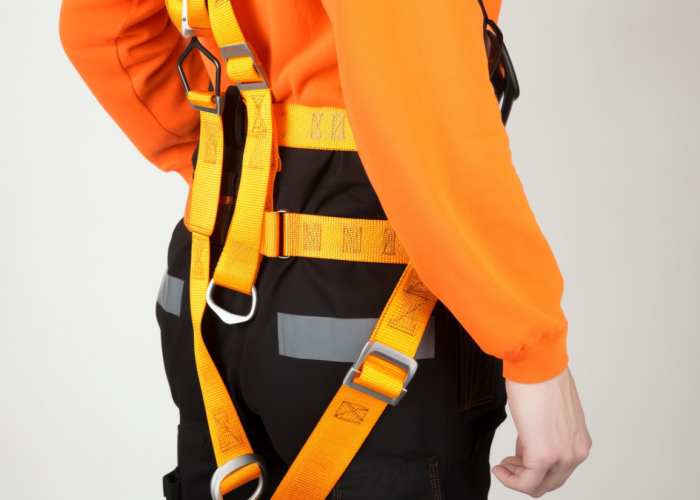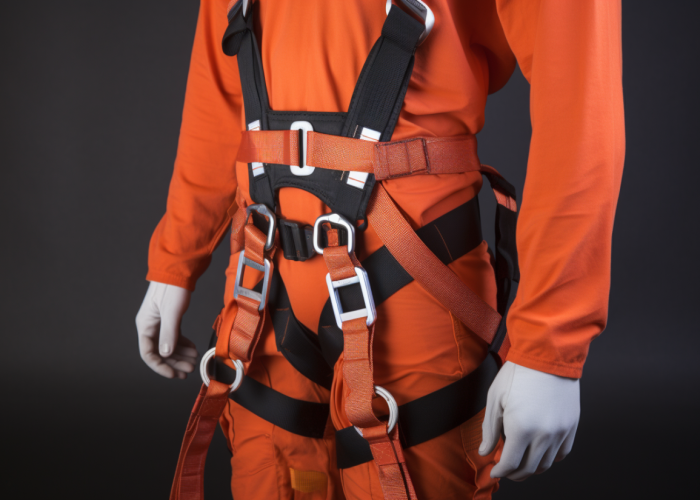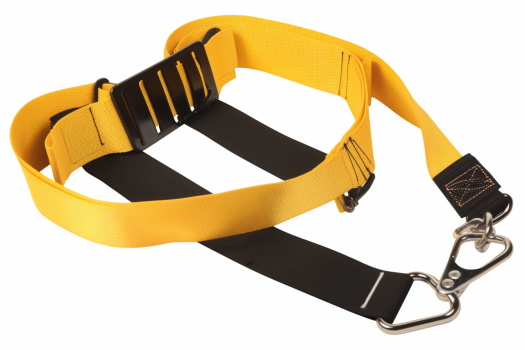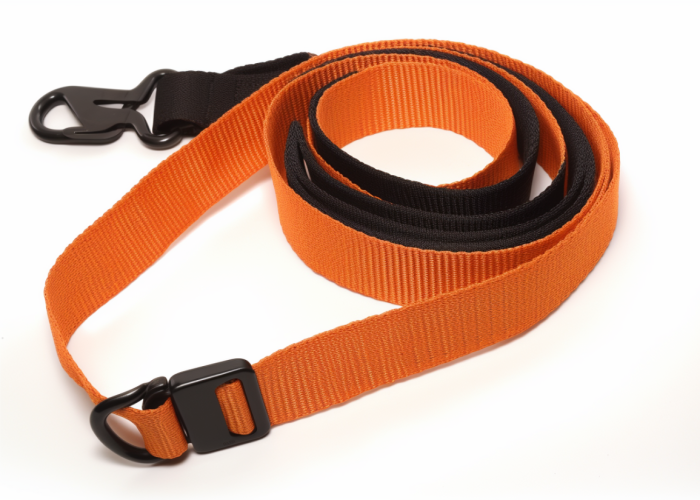Engineering tower safety systems demand specialized webbing solutions. As custom webbing manufacturers, we develop positioning straps with precise material properties and hardware integration tailored to your product specifications helping you create safer, more effective tower positioning equipment.
Tower positioning straps are specialized webbing systems engineered to secure workers on telecommunication and electrical towers. These high-performance products feature reinforced materials with UV protection and precise tensile properties that provide superior positioning capability while integrating with specialized hardware for optimal safety.
Explore specs, compliance, and custom options for tower positioning webbing—built to meet your safety needs with advanced materials and precision manufacturing.


Webbing manufacturing expert with 15+ years of experience helping product developers build high-performance straps for industrial, medical, and outdoor use.
Tower positioning straps are primarily made from high-strength synthetic webbing materials including nylon, polyester, and specialized polyamide blends engineered for UV and thermal resistance. These materials undergo rigorous treatment processes to enhance durability while maintaining critical flexibility for tower work applications. The specific composition varies based on intended load capacity and environmental exposure conditions.
At a Glance:
High-performance tower positioning webbing integrates specialized polymer structures providing superior tensile strength while preserving controlled elasticity. Type 6,6 nylon remains a primary component in premium tower straps due to its longer polymer chains and enhanced hydrogen bonding.
The webbing undergoes precision tension weaving creating uniform load distribution. Specialized herringbone patterns provide up to 15-20% greater resistance to edge abrasion compared to standard weaves.
Advanced UV protection incorporates stabilizing compounds that penetrate the polymer structure rather than merely coating the surface. This integration provides UV resistance lasting 3-5 years in continuous exposure environments.
Specialized thermal-resistant formulations maintain structural integrity up to 400°F for critical exposure periods. Custom material solutions can be developed for environments such as offshore platforms, desert installations, or arctic field operations.
Metal field-fixing processes integrate hardware components with tower positioning webbing through specialized connection points designed for maximum load distribution and minimal stress concentration. These engineered interfaces combine precisely machined metal components with reinforced webbing sections to create secure attachment points that maintain strength under dynamic loading conditions. The integration method significantly impacts overall system performance and longevity.
At a Glance:
Hardware integration for tower positioning systems utilizes specially designed connection interfaces that distribute forces across the webbing structure. Field-fixing components incorporate radiused edges and load-spreading features that prevent localized stress points.
Connection systems employ self-checking mechanisms that provide visual verification of proper assembly. These systems include color-coded indicators and tactile feedback elements ensuring proper engagement even in low-visibility conditions.
Advanced corrosion-resistant alloys extend service life in harsh environments while maintaining critical mechanical properties. Hardware components undergo rigorous testing including salt-spray exposure and cyclical loading to validate long-term performance.
Field serviceability remains a critical design consideration for tower positioning hardware. Components can be replaced or maintained on-site without compromising the integrity of the webbing system, reducing downtime and extending service life.

Tower positioning straps must meet rigorous testing standards including ANSI Z359.3, OSHA 1910.269, and CSA Z259.1-05 for load capacity, environmental resistance, and dynamic performance. These comprehensive testing protocols verify product performance under normal and extreme conditions through a series of standardized procedures. Compliance requires documented testing by certified facilities with complete traceability throughout the development process.
At a Glance:
Impact load testing subjects positioning straps to dynamic forces of 22kN (5,000 lbs) to verify structural integrity under sudden loading conditions. This testing exceeds normal working loads by a significant safety factor to ensure consistent performance.
Dynamic testing evaluates strap performance under cyclical loading conditions that simulate real-world usage patterns. Protocols include up to 5,000 cycles at 75% of rated load to verify longevity and performance degradation characteristics.
Environmental resistance testing exposes straps to UV radiation, extreme temperatures, and chemical contaminants to validate material stability. These accelerated aging tests simulate years of field exposure in controlled laboratory conditions.
Compliance documentation provides complete traceability from raw materials through final testing. Each positioning strap carries permanent identification that references specific lot information and testing certification records for verification.
Positioning straps are engineered for constant tension during work positioning while fall arrest webbing is designed to absorb energy during fall deceleration. This fundamental difference affects material selection, webbing construction, and hardware integration throughout the entire system. Positioning straps prioritize controlled flexibility and dimensional stability while fall arrest systems maximize energy absorption and deceleration distance.
At a Glance:
Material selection for positioning straps prioritizes dimensional stability under sustained loading. These materials exhibit minimal creep characteristics even after extended use, maintaining precise positioning capability throughout their service life.
Webbing construction in positioning systems utilizes tighter weave patterns that provide superior abrasion resistance. These patterns create a more stable structure compared to the specially designed energy-absorbing weaves found in fall arrest webbing.
Hardware integration for positioning straps centers on maintaining fixed working positions rather than managing dynamic fall forces. Connectors and adjustment mechanisms prioritize secure holding capability under variable tensions rather than impact resistance.
Regulatory requirements classify positioning straps and fall arrest systems as distinct safety categories with different certification standards. Positioning equipment must meet specific work positioning standards while fall arrest systems require separate certification for energy absorption.

Tower safety equipment is advancing through self-healing polymers, advanced UV-resistant compounds, and next-generation high-tenacity fibers with enhanced environmental resistance. These material innovations extend service life while improving performance in extreme conditions encountered in tower environments. Emerging manufacturing technologies enable more precise control of webbing properties through the entire cross-section rather than just surface treatments.
At a Glance:
Self-healing properties enable webbing to recover from minor damage through innovative polymer structures. These materials incorporate microencapsulated healing agents that activate upon fiber damage, sealing small cuts and preventing propagation of damage.
Advanced UV-resistant compounds provide protection throughout the material structure rather than depending on surface coatings. This technology maintains crucial mechanical properties even after years of direct sunlight exposure in elevated environments.
High-tenacity fiber development offers superior strength-to-weight ratios through molecular orientation control. These advanced fibers maintain critical performance characteristics across broader temperature ranges than conventional materials.
Integrated monitoring capabilities represent the frontier of tower positioning technology. Emerging smart materials can provide real-time feedback on strap condition, loading history, and remaining service life through visual indicators or electronic systems.
Tower positioning products can be customized through material formulation, webbing pattern design, width/thickness optimization, and specialized hardware integration to meet specific application requirements. These customization options allow product developers to address unique environmental challenges, load specifications, and installation configurations. Performance characteristics can be precisely tailored to optimize positioning systems for specific tower types and work methodologies.
At a Glance:
Material formulation customization enables precise control of performance characteristics including UV resistance, thermal stability, and chemical compatibility. Custom polymer blends can be developed for specific environmental challenges such as extreme cold, marine exposure, or industrial contaminants.
Webbing design options include variations in width, thickness, and weave pattern to optimize load distribution. These parameters can be adjusted to provide ideal handling characteristics while maintaining required strength specifications for specific applications.
Hardware integration can be customized through specialized connection points engineered for specific tower structures. These integration systems address unique mounting challenges while maintaining compliance with relevant safety standards.
Application-specific features can be incorporated to address particular working conditions or installation requirements. These specialized elements include enhanced visibility options, simplified adjustment mechanisms, or configuration-specific attachment points.

Specialized tower webbing delivers superior performance through application-specific engineering, enhanced environmental resistance, and optimized hardware integration compared to standard safety straps. These purpose-built systems provide greater positioning precision, extended service life, and improved worker safety in elevated environments. The technical advantages translate directly to operational benefits including reduced maintenance requirements and enhanced work efficiency.
At a Glance:
Application-specific engineering addresses the unique challenges of tower environments through purpose-built solutions. Unlike general-purpose safety webbing, tower positioning straps are designed exclusively for the specific demands of elevated work environments.
Enhanced environmental performance ensures consistent operation in extreme conditions including intense UV exposure, temperature fluctuations, and industrial contaminants. This specialized resistance extends service life and maintains critical safety margins.
Technical design advantages include optimized handling characteristics that improve worker efficiency and reduce fatigue. Specialized adjustment mechanisms provide precise positioning control while maintaining secure connections.
Comprehensive testing specific to tower applications validates performance under realistic usage scenarios. This targeted validation ensures reliability in the specific conditions encountered during tower installation and maintenance activities rather than generalized safety applications.
Tower positioning strap engineering requires specialized materials, rigorous testing, and application-specific design to ensure worker safety in elevated environments. Our custom webbing manufacturing capabilities deliver precisely engineered solutions with optimized performance characteristics for your specific requirements. From material formulation to hardware integration, we provide complete customization options to address your unique tower safety challenges.
Tower positioning straps primarily use high-strength synthetic materials including Type 6,6 nylon, specialized polyester, and polyamide blends. These materials undergo treatments for UV resistance and thermal stability while maintaining precise tensile properties required for worker positioning in elevated environments.
Tower positioning straps are manufactured through precision tension weaving with specialized patterns designed for uniform load distribution. The manufacturing process includes controlled fiber orientation, reinforced edge treatments, and integrated connection points engineered to eliminate stress concentration while maximizing strength-to-weight ratio.
Tower positioning straps must meet ANSI Z359.3, OSHA 1910.269, CSA Z259.1-05, and EN 358 standards. These regulations require minimum breaking strength of 22kN (5,000 lbs), specific environmental resistance testing, and comprehensive documentation of test results with permanent product identification.
Product developers should consider connection point reinforcement, hardware compatibility, field serviceability, and application-specific customization when integrating tower positioning webbing. These factors determine how effectively the webbing interfaces with other system components while maintaining overall safety performance and regulatory compliance.
Tower positioning straps feature application-specific designs with controlled stretch characteristics, enhanced environmental resistance, and specialized hardware integration not found in standard safety webbing. These purpose-built systems prioritize positioning precision and dimensional stability under sustained loading rather than general-purpose protection.
Material selection directly impacts critical performance factors including UV resistance, thermal stability, abrasion resistance, and load-bearing characteristics. The right materials ensure consistent performance across temperature extremes (-40°F to 400°F), extended service life in harsh environments, and precise positioning control throughout the product lifecycle.